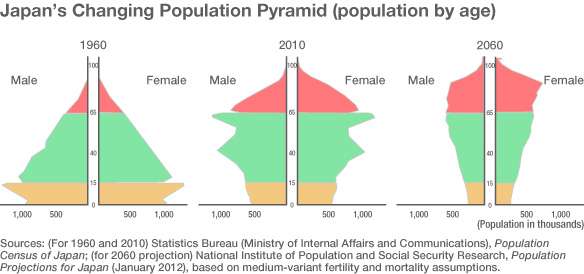What happens when you build a pyramid upside down?

On Tuesday, September 29th 2015, Canada achieved a milestone. For the first time in history, the number of people aged 65 and older outnumbered those aged 0 – 14 years of age. A shocking 16% of Canadians – almost one in six – were at least 65 years of age. This is just the start of a bigger trend though, as by 2024, it is predicted that this percentage will grow to 20%, while the share of children will remain stagnant at 16%.
This is pretty new for Canada. However, other industrialized nations have been dealing with this for a while. Japan in particular has become the poster child for the so-called "kite" population distribution, with hard data from 2010 showing that they were tottering on the edge of a top heavy distribution. This has serious consequences for a country. Not only does this result in more people retiring from the workforce, it can also be accompanied by a shrinkage in the economy that occurs as a result of these people not being replaced. Unless productivity per capita can increase dramatically, there are turbulent times ahead for the Japanese economy (and indeed, many other world economies that are undergoing the same transition).
So what does this mean? What is the result of an aging population? Well, the age of retirement has to increase. With average life expectancy ranging between around 75-85, people can realistically expect to live over a decade after retirement, or potentially longer. For a workforce that shrinking but still expected to support retirees, this is simply unsustainable. This is further exacerbated by under- and unemployment among young people, who don't have secure, stable employment (precarious employment has become a new buzzword that gives me shivers). But even if the workforce did have secure positions that paid well, this population trend would continue, unabated and unyielding. In Japan, the working population had 83 million people in 1985, and this will drop to 63 million in 2035. Meanwhile, the elderly population will increase from 17 million to 60 million in that same time period, growing from 10.3% of the population to 33.4% of the population.
There are also consequences for the healthcare system. As this population ages, those in government-funded systems will have to pay more. The so-called "oldest old" (85+) will have multiple medical conditions and will require specialized care and treatment, which won't be cheap. Since the elderly are almost universally the age group with the highest voter turnout, their issues are attended to and discussed, while issues that impact younger people are left by the wayside. This isn't good for seniors either. Difficulties faced by young people in finding employment results in many of them helping their children financially, either through down payments for homes, helping them financially with debt, or by children moving back in with their parents.
Which leads me to the answer to the question posed above: what does happen when you build a pyramid upside down? Well, just ask the Minions.

Provided by Public Library of Science
This story is republished courtesy of PLOS Blogs: blogs.plos.org.



















